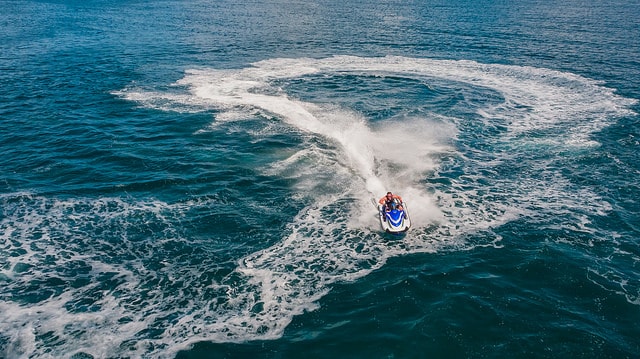
You may be wondering what a rooster tail on a Personal Watercraft (PWC) is. I have done the research, and can confidently tell you not only what it is, but why it is on your PWC.
A rooster tail is the narrow stream of water that shoots up out of a small tube on the back deck of Kawasaki Jet Skis and other PWCs. It is there primarily to make your watercraft visible to other boaters as a safety precaution.
In the world of an avid jet skier, the rooster tail is quite a controversial topic. If you are looking to learn a little more, greater detail is included below.
Rooster Tail Origin
Yamaha released its first Super Jet in 1986, and ever since then, they have been one of the top PWC producers worldwide. While their PWCs are extremely popular, one of the least loved features they sport is the rooster tail.
Almost any PWC user that you talk to will express one of these two mainstream opinions.
The one side is the family-friendly, “wow that’s pretty,” “It makes a rainbow” side. These people are generally the people who embrace the safety that the rooster tail provides and at the same time they love the look.
The other (and larger) group, are those who are a little rougher around the edges, they like their PWCs fast and they don’t appreciate the annoying spray that hits them at slower speeds.
The rooster tail is also despised by the people who are being towed behind the jet ski on a tube or a wakeboard. The rooster tail sprays right up in the air and soaks the one being pulled behind.
I can totally see where everyone is coming from, personally, I do like the look, but when riding behind a personal watercraft I really do not appreciate the spray. Overall, the safety value outweighs the potential annoyance. On a busy lake, the danger is real.
Especially being a small watercraft, you can easily be missed. Leaving the roostertail in tact could end up saving your life, or at least keep you from a nasty crash.
Why is it There?
The water that is fed into the rooster tail is pulled directly from the jet. The jet pulls the water through, propelling the jet ski and at the same time cooling down the jet ski engine.
When the jet of water is on its way out, a portion of the water is diverted into a tube that is pointed vertically at the rear of the deck. This causes the “rooster tail” effect.
The reason they incorporate the rooster tail is for safety reasons. Because of the 10 feet spurt of water in the air, people who are near or far away can see you. The tail creates the rainbow effect when the light reflects off the mist of water. If there is another watercraft or boat coming close to you, they will be able to see the water shooting up and know they are to stay away from you.
This is a great safety precaution that Yamaha built into their PWC, but many consumers wish that there was a switch or a valve to control when, and where to use this feature.
Rooster Tail Safety Precautions
Even though the rooster tail can protect you from danger, it can also cause danger to other riders if it is not used in the right ways and for the right reasons.
There are things you should NOT do when you have a rooster tail on the back of your jet ski.
- Do not cruise next to another boat or PWC to purposely spray the people on them with your rooster tail stream.
- If you are towing a tube or a water ski behind you, make sure the rope is long enough so that the rooster tail stream does not spray in their faces. This can cause them to be distracted and fall off.
- It is important to be aware that your rooster tail stream can be delayed in the air and can still hit people who are coming up behind you.
- Stay out of other boaters wake so that the water will not spray them, and vice versa.
How to Remove the Rooster Tail
Across every forum, I have seen the main conversation surrounding the rooster tail feature is “How can I remove it?”
The rooster tail can be removed. Those who use their PWCs to pull a tube or skier behind may consider removing their rooster tail because of it spraying those you are towing behind. You can reconnect the rooster tail if you decide to go solo on your watercraft.
That being said, when working with any type of engine or pressurized system, you better do your homework before you start loosening bolts or re-routing hoses.
Here are the basic steps for removing the rooster tail:
- Find the output hole that the water sprays out of. It will be mounted on the floor.
- Under the floor near the jet, remove the hose clamp that connects the hose to the connector. Do this using a Phillips screwdriver.
- Pull the hose off of the connector with your hand.
How to Reconnect the Rooster Tail
- Attach the hose to the connector under the floor near the jet. Use your hand to push the hose on it.
- Using a Phillips screwdriver, connect the hose clamp that connects the hose to the connector.
- Once you connect, close the floor and test your jet ski to see if it sprays.
This information was provided by itstillruns.com!

Adding a Rooster Tail to your PWC
There are ways to create your own rooster tail, but these “ways” would be more of a redneck or do it yourself project, with a few aftermarket kits available.
If you want a rooster tail, I recommend buying a jet ski that has one already.
There is a nozzle you can purchase that diverts a small amount of water from the jet into a small pipe that shoots it up into the air. This If you are familiar with your jet ski nozzle and how it works, you may be able to pull this off. All I will say is good luck.
If you already have a PWC that does not have a rooster tail installed, you can always use your orange neon flags and your whistle to alert others around you.
